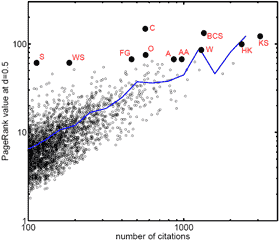PageRank predicts Nobel prize winners
 Ranking scientists by the number of links to their work — a thankless job. Anyone can name a few weaknesses of this system.
Ranking scientists by the number of links to their work — a thankless job. Anyone can name a few weaknesses of this system.1. Not all links are the same. The importance of reference work is an important factor.
2. Scientists from different fields of science use quotations and references in different ways. Work in the field of life Sciences is cited six times, work in physics to three times, and math — is only one.
3. Breakthrough work can be cited rarer because they involve niche research area at an early stage of their development.
4. Important work often stop to quote when they get in the textbooks.
The pattern of cross-references between scientific papers forms a complex network similar to the network of hyperlinks on the Internet. Maybe that is the key to opening the best way to assess the importance of the particular work?
Sergei Maslov of Brookhaven national laboratory in new York and Sidney Redner from Boston University have asked themselves the same question, and suggested that the Google PageRank algorithm may help a little to understand the problem.
As in the case of web pages, PageRank for scientific papers takes into account not only the number of incoming links, but the "weight" of each scientific work, where the link goes. This weight is calculated in turn, the number of incoming links to it. So quotes in the important works are valued higher.
Maslov and Redner have applied the algorithm to 353 268 articles, published by the American physical society since 1893 in journals such as Physical Review Letters. And the results really are encouraging.
That's what they did the first ten:
1. Unitary Symmetry &Leptonic Decays by Cabibbo
2. Theory of Superconductivity by Bardeen, Cooper &Schrieffer
3. Self-Consistent Equations... by Kohn &Sham
4. Inhomogeneous Electron Gas by Hohenberg &Kohn
5. A Model of Leptons by Weinberg
6. Crystal Statistics... by Onsager
7. Theory of the Fermi Interaction by Feynman &Gell-Mann
8. Absence of Diffusion in... by Anderson
9. The Theory of Complex Spectra by Slater
10. Scaling Theory of Localization by Abrahams, Anderson, et al.
It is an impressive list. Most importantly, almost all of these authors are Nobel prize winners (curiously, the author of the first work in the list, Cabibbo, received not the Nobel. This should attract the attention of the Nobel Committee, which awarded the last prize in physics for Japanese researchers than the work is based on the ideas of Cabibbo).
All this tells a simple idea. You can track updates to this list, what would be a good way of predicting future Nobel laureates.
Комментарии
Отправить комментарий